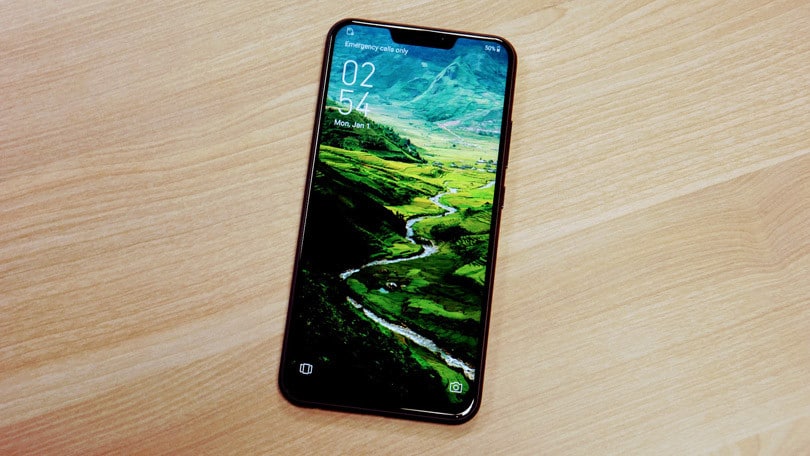
BARCELONA—Feature diffusion is a fast process in the phone market. The high design, hardware, and software features you see on flagship phones usually end up on midrange devices within six months. The Asus ZenFone 5 and ZenFone 5 Lite, both announced at Mobile World Congress, are here to prove that point. We went hands on with them before the launch.
All About the Notch
The ZenFone 5 is the more premium of the two, incorporating a distinctive, nearly edgeless 19:9 aspect ratio and an overall look that’s more or less a carbon copy of the Apple iPhone X (below, right), complete with notch cutout and camera layout. The front is all glass, a band of metal wraps along the sides, and the back is a highly polished mirror finish (midnight blue or meteor silver) that’s an absolute fingerprint magnet and a bit on the slippery side; you’ll certainly want to keep it in a case.
The unusual aspect ratio and the wraparound “wings” of the display make the phone look striking for all the same reasons as the iPhone X$999.00 at Verizon Wireless. There’s a 6.2-inch 2,246-by-1,080 IPS display that can hit a solid 500 nits of brightness. Colors on the screen pop, with images seemingly pressed up against the glass. Viewing angles are great and generally it’s quite a nice screen to look at and use. It won’t match the Quad HD panel on the Samsung Galaxy S9+ in sharpness, but it’s nearly on par with the Sony Xperia XZ2 and technically the iPhone X if we’re going by raw pixel count.
Asus claims the display has AI features, like automatic color temperature adjustment, but that’s misleading marketing at best since it’s not using machine learning, just responding to an input. Similarly, keeping the screen on when you’re looking at it is a feature we’ve on various Samsung phones and isn’t AI.
A Smart Camera
Looks and nice display aside, what Asus is really trying to sell you on here is the camera capabilities. The primary rear camera is a 12MP sensor with an 83-degree field of view paired with a second 8-megapixel, 120-degree wide angle lens. The front camera is another 8-megapixel, 83-degree field of view lens. You can take wide angle shots of course, capturing more of your surroundings with relatively minimal barrel distortion. There’s also optical image stabilization, 4K video recording, and the wide variety of camera modes for which Asus is known.
But what makes the sensors stand out is Intelligent Scene detection. Like the Huawei Mate 10 Pro, the ZenFone 5 can recognize certain settings and objects to find the best adjustment for contrast, white balance, focus, and shutter speed. That includes people, food, animals, plants, flowers, sunsets, night scenes, text, snow, and other settings.
This is real AI since the phone is using machine learning to not only identify pictures, but to make the adjustments according to your preferences and what makes the photo look best. With each photo, you’re asked for your approval, and the phone stores this information and updates its adjustments accordingly as it learns what you like.
In my testing in the demo area, Intelligent Scene detection seemed to work, but was a little hit or miss. Not only was it slow, it frequently mistook a cactus for food, which is perhaps the last thing you want to eat. Still, this is clearly non-final software, so we’ll reserve judgment until we get a unit in for review.
Solid Power
The Zenfone 5 is powered by a newer midrange processor, the Qualcomm Snapdragon 636, with configurations of 4GB RAM/64GB storage and 6GB RAM/64GB of storage. You can also expand storage up to 2TB with microSD card and dual SIMs are supported, with dual 4G and dual VoLTE enabled.
Under the hood is a 3,300mAh battery. The phone comes running Android 8.0 Oreo, Asus Zen UI 5.0 running on top. It’s fairly lightweight compared to previous devices. Asus removed stock apps that duplicate Google apps and eliminated other bloatware aside from Facebook, Instagram, and a few Asus features like its Audiowizard for tuning frequency response and AI Boost which pushes more power to improve performance. That said, making any judgment on performance is premature at this point since we used an early model and encountered several app crashes and camera app freezes.
The ZenFone 5 Lite is the more affordable version of the ZenFone 5. You get a more standard 18:9 screen 6-inch 1080p screen that looks rather drab next to its flashier sibling. On the plus side, there’s no notch.
The design is similar otherwise; you get the same glossy back, which is a fingerprint magnet, a back fingerprint sensor, and dual cameras. The one difference is that the Lite has dual sensors for the selfie camera as well and runs older versions of things like Audiowizard. Pricing and availability isn’t known yet, but we expect it to fall into the midrange segment and compete with phones like the Honor 7X.
